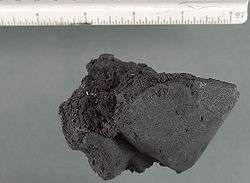Black tar heroin
Black tar heroin is a free base form of heroin that is sticky like tar or hard like coal. Its dark color is the result of crude processing methods that leave behind impurities. Despite its name, black tar heroin can also be dark orange or dark brown in appearance. It is generally less expensive than other forms of heroin.[1]

Black tar heroin is impure morphine diacetate. Other forms of heroin require additional steps of purification post acetylation. With black tar the product's processing stops immediately after acetylation. Its unique consistency however is due to acetylation without a reflux apparatus. As in homebake heroin in Australia and New Zealand the crude acetylation results in a gooey mass.
Black tar as a type holds a variable admixture morphine derivatives—predominantly 6-MAM (6-monoacetylmorphine), which is another result of crude acetylation. The lack of proper reflux during acetylation fails to remove much of the moisture retained in the acetylating agent, glacial acetic acid.
Black tar heroin is often produced in Latin America,[2][3] and is most commonly found in the western and southern parts of the United States, while also being occasionally found in Western Africa. It has a varying consistency depending on manufacturing methods, cutting agents, and moisture levels, from tarry goo in unrefined form to a uniform, light-brown powder when further processed and cut with lactose.
Composition
Pure morphine and heroin are both fine powders. Tar's unique appearance and texture is due to its acetylation without benefit of the usual reflux apparatus.
The assumption that tar has less adulterants and diluents is a misconception. The most common adulterant is lactose, which is added to tar via dissolving of both substances in a liquid medium, reheating and filtering, and then recrystallizing. This process is very simple and can be accomplished in any kitchen with no level of expertise needed.
The price per kilogram of black tar heroin has increased from one-tenth that of South American powder heroin in the mid-1990s to between one-half and three-quarters in 2003 due to increased distributional acumen combined with increased demand in black tar's traditional realm of distribution. Black tar heroin distribution has steadily risen in recent years, while that of U.S. East Coast powder varieties has dropped; heroin production in Colombia has decreased[4] as U.S.-funded efforts to eradicate Colombian poppy fields continue.[5]
Health effects
People who intravenously inject black tar heroin are at higher risk of venous sclerosis than those injecting powder heroin. In this condition, the veins narrow and harden which makes repeated injection there nearly impossible.
The presence of 6-monoacetylcodeine found in tar heroin has not been tested in humans but has been shown to be toxic alone and more toxic when mixed with mono- or di- acetyl morphine potentially making tar more toxic than refined diamorphine.
Black tar heroin injectors can be at increased risk of life-threatening bacterial infections, in particular necrotizing soft tissue infection. The practice of "skin-popping" or subcutaneous injection predisposes to necrotizing fasciitis or necrotizing cellulitis from Clostridium perfringens, while deep intramuscular injection predisposes to necrotizing myositis. Tar heroin injection can also be associated with Clostridium botulinum infection.[6]
Alternative routes of administration
In some parts of the United States, especially the lower states, black tar may be the only form of heroin that is available. Many users do not inject.
- Grinding into a powder form: This is one of the more popular ways of consuming black tar to those who do not wish to use needles. The black tar heroin is put into some sort of blender and mixed in with lactose. This creates a fine black powder product that can be easily snorted.
- Water looping: Water looping is when a user places the heroin in an empty eye dropper bottle, or a syringe with the needle removed. The user allows the heroin to completely dissolve into water and the solution is dropped into the nose. This at times can be wasteful if a user allows too much of the solution to go down the throat.
- Vaporizing (Chasing the dragon): A user puts the heroin on a piece of foil and heats the foil with a lighter underneath it. The user uses a straw or similar apparatus and inhales the vapor.
- Drinking: This is less common due to the lower bioavailability, but it is done similar to the water looping method. Instead of being delivered through the nose, the solution is swallowed.
- Suppository: The most effective route of administration which does not require a needle, accomplished by delivering a solution (via syringe) or lubricated mass of the narcotic deep into the rectum or vagina. This can lead to internal bleeding.
References
- http://iprc.iu.edu/training/courses/heroin/a_01_04_01.html
- "Mexican Drug Exports", retrieved 2015/04/04
- "Heroin by Area of Origin", retrieved 2015/04/04
- NDIC
- "A lethal business model targets Middle America" Los Angeles Times, February 18, 2010
- Passaro DJ, Werner SB, McGee J, Mac Kenzie WR, Vugia DJ (March 1998). "Wound botulism associated with black tar heroin among injecting drug users". JAMA. 279 (11): 859–63. doi:10.1001/jama.279.11.859. PMID 9516001.
External links
- National Drug Threat Assessment 2005, National Drug Intelligence Center. Accessed 30 December 2019.
- Heroin, Interpol Drugs Sub-Directorate at the Library of Congress Web Archives (archived 2001-09-24). Accessed 15 December 2005.